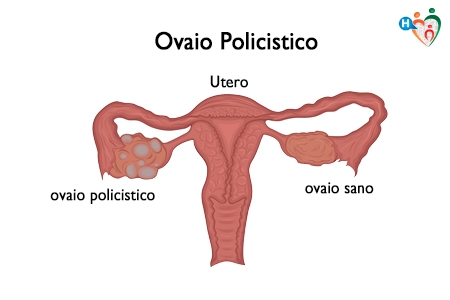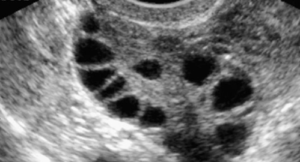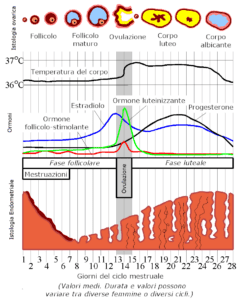
I contracettivi orali (CO, pillola) sono solitamente prescritti dal ginecologo per regolare il ciclo mestruale della paziente con PCOS. Questa terapia standard non è per niente la migliore. Esiste un’alternativa più logica, che in realtà funziona meglio, ovvero il progesterone bioidentico che è un’alternativa di gran lunga migliore delle pillole anticoncezionali. Ma vedremo poi perché. La PCOS è il risultato finale di un’assenza di ovulazione, (con conseguente assente produzione di progesterone) per un lungo periodo di tempo (alcuni anni), che esita in un circolo vizioso che perpetua l’anovulazione, causando un aumento della produzione di testosterone da parte dell’ovaio. Il diabete insulino-resistente e l’obesità aggravano il problema.
Come ci si potrebbe aspettare, la PCOS è una delle principali cause di infertilità.
La PCOS era rara quando venne descritta per la prima volta nel 1935 da Stein e Leventhal, ed è ai giorni nostri abbastanza comune. Perché questo aumento di incidenza? Alcuni ritengono che la colpa sia da attribuire alle sostanze chimiche che alterano il sistema endocrino nell’ambiente. La Sindrome dell’ovaio policistico (PCOS) è uno dei disordini endocrini più comuni della donna in età riproduttiva e può colpire il 10% delle donne e costituisce il 30% delle visite ginecologiche. La PCOS è la causa più frequente di infertilità.
Caratteristico per la PCOS sono cicli anovulatori (senza ovulazione) che si traducono in cicli irregolari, lunghi o sanguinamenti protratti e elevati livelli di androgeni (ormoni maschili) con irsutismo, acne, perdita di capelli, infertilità. L’irsutismo è un’eccessiva crescita di peli sul viso e sul corpo. Una peluria sopra le labbra superiori non è irsutismo ed è frequente. Il vero irsutismo è caratterizzato da peluria eccessiva su mento, guance, pancia e intorno ai capezzoli.
In pratica la PCOS è un problema di ovulazione assente con conseguente iperproduzione di androgeni come testosterone e altri androgeni. Gli androgeni sono ormoni sessuali maschili come testosterone, androstendione e DHEA. Sono necessari per il nostro umore, la libido, ossa sane. Se sono in eccesso possono causare acne, perdita di capelli, irsutismo.
Segni clinici e sintomi della PCOS:
1) Irregolarità del ciclo mestruale: oligomenorrea o amenorrea (nessuna mestruazione), anovulazione (assenza di ovulazione)
2) Eccesso di androgeni (irsutismo, alopecia androgenetica, acne)
3) Aumento di peso, obesità
4) Resistenza all’insulina (pre-diabete),
5) Infertilità e aborti,
6) Disturbi dell’umore
7) Molteplici piccole cisti ovariche all’ecografia,
8) Acanthosis Nigrans (comparsa di macchie scure della pelle con una consistenza spessa e vellutata specie alla nuca e sotto le braccia), indice di iperinsulinemia.
Definizione di ovulazione: È il momento in cui un ovulo esce dal follicolo dell’ovaio e inizia il lungo viaggio lungo la tuba di Faloppio fino alla cavità uterina dove può essere fecondato per formare un nuovo embrione. L’ovulazione provoca un’elevata produzione di progesterone da parte del corpo luteo nell’ovaio. I cicli mestruali sono regolari.
Definizione di Anovulazione: L’ovulo non esce fuori e non c’è produzione di progesterone. I cicli sono irregolari o assenti.
Normale ciclo femminile: Livelli ormonali durante il ciclo mestruale con ovulazione normale. La linea nera è il progesterone che sale dal 14. al 22. giorno. Il progesterone è assente nella PCOS, perché non c’è ovulazione, e la linea nera rimane piatta sul grafico, invece di salire.
Irregolarità del ciclo mestruale. Nonostante la frequenza di anomalie del ciclo mestruale nella PCOS, circa il 30% delle pazienti hanno cicli mestruali normali. Le anomalie mestruali nella PCOS sono causate dall’anovulazione cronica e comprendono l’oligomenorrea (mestruazioni poco frequenti, di solito meno di nove mestruazioni all’anno) e l’amenorrea (assenza delle mestruazioni per sei mesi o più). Circa l’85%-90% delle donne con oligomenorrea ha la PCOS mentre il 30%-40% delle donne con amenorrea avrà la PCOS.
Eccesso di produzione di androgeni. Gli androgeni sono ormoni che influenzano principalmente la crescita e lo sviluppo del sistema riproduttivo maschile. L’androgeno più attivo è il testosterone che negli uomini è prodotto principalmente dai testicoli. Altri androgeni sono prodotti principalmente dalla corteccia surrenale, e nelle donne dalle ovaie. Nelle donne sane, le ovaie e le ghiandole surrenali producono circa il 40% – 50% del testosterone del corpo. La sovrapproduzione di androgeni (iperandrogenismo), come avviene nelle donne con PCOS, provoca lo sviluppo di caratteristiche maschili, manifestandosi clinicamente con eccesso di peli sul corpo in un modello di distribuzione maschile. I peli si vedono comunemente sul labbro superiore, sul mento, intorno ai capezzoli e lungo la linea alba del basso addome. Alcune pazienti subiscono una perdita di capelli di tipo maschile (alopecia androgenetica). Anche l’acne e la seborrea possono verificarsi in PCOS. La seborrea è un problema cutaneo comune. Provoca un’eruzione cutanea rossa e pruriginosa e scaglie bianche. Quando colpisce il cuoio capelluto, viene chiamata “forfora”.
Tipici segni quindi di iperandrogenismo sono:
• Irsutismo (peluria al viso e al corpo), di solito con peli lunghi e scuri, specie alle guance, addome e intorno ai capezzoli.
• Acne, specie di tipo ormonale al mento, nell’adulto può essere indice di eccesso di androgeni. Non invece nell’adolescente.
• Alopecia androgenetica: perdita di capelli e capelli sfibrati in follicoli piliferi piccoli.
Infertilità e aborti. La PCOS è una causa comune di infertilità, sebbene solo una parte di donne con PCOS sia sterile. La maggior parte può ovulare a intermittenza rendendo possibile una gravidanza. D’altra parte, il concepimento può richiedere più tempo e le donne con PCOS possono avere meno figli del previsto. Inoltre, il tasso di aborti spontanei è aumentato.
Disturbi d’umore. Le donne con PCOS possono avere più probabilità di avere disturbi dell’umore come la depressione e l’ansia rispetto a donne senza PCOS. Questi sintomi sono importanti da riconoscere in quanto possono avere un serio impatto sulla qualità della vita. L’alterazione della qualità della vita dovuta a problemi di immagine corporea può causare stanchezza, disturbi del sonno, fobia, cambiamenti dell’appetito e abbuffate.
La PCOS non è la stessa cosa delle cisti ovariche. Le cisti che si vedono agli ultrasuoni non sono una crescita anormale. Un ovaio normale produce follicoli riempiti di liquido che contengono gli ovuli. Questi follicoli sono essenzialmente “cisti”. Le cisti normali (che l’ovaio dovrebbe avere) si formano e vengono riassorbite ogni mese, in ogni donna. Follicoli di numero e dimensioni diverse saranno visibili in ogni ovaia normale. Appariranno diversi ad ogni ecografia. È solo quando i follicoli ovarici non si formano correttamente, che il concetto di cisti anomala ha un qualche significato. I follicoli possono essere troppo grandi (il tipo di “cisti ovariche” che può causare dolore o rottura), o troppo piccoli (come si vedono nelle ovaie policistiche). Ovaie policistiche o ‘ovaie a cisti multiple’ significa che le ovaie – al momento della ecografia – hanno troppi follicoli piccoli e sottosviluppati. Questo si verifica perché l’ovulazione non si è verificata correttamente in quel mese. Potrebbe essere completamente differente dopo uno o due mesi.
L’assenza di un’ovulazione corretta può dipendere da una serie di cause, ma nella vera PCOS, è dovuta a un problema con il testosterone, e spesso, a un problema con l’insulina. QUINDI!!!!! L’aspetto policistico può non significare nulla – può essere perfettamente normale. Oppure le ovaie possono apparire in questo modo perché qualcosa impedisce all’ovulazione di progredire normalmente. Quel “qualcosa” è o l’insulina o altre cause: ne parlerò tra breve. Le ovaie stesse non sono la causa dell’aumento di peso. Nelle PCOS con insulinoresistenza è proprio l’insulino-resistenza la causa dell’aumento di peso. L’insulino-resistenza è anche la causa dell’aspetto policistico delle ovaie, della mancanza di un’adeguata ovulazione e quindi dell’assenza di cicli. Nella maggior parte dei casi, la PCOS non è una condizione permanente: infatti con la giusta diagnosi e il giusto trattamento, la PCOS si può risolvere.
Diagnosi di PCOS
Non esiste un test univoco ed unico per diagnosticare la PCOS. L’anamnesi e l’esame fisico possono rilevare un’anamnesi familiare positiva e sintomi come cicli irregolari o saltati, cambiamenti di peso, modifica dell’aspetto dei capelli, acne, acantosi nigricans e obesità centrale. Gli esami di laboratorio, incluso l’assetto glicometabolico (glicemia, HbA1c, insulina), i livelli di androgeni e altri ormoni sono preziosi.

Uno studio ha trovato che donne sane hanno almeno nel 25% del tempo ovaie policistiche. Inoltre donne adolescenti possono avere normalmente fino a 25 follicoli per ovaio: molti di più rispetto a donne più anziane.
È inoltre importante sottolineare che le ovaie policistiche, a differenza di altre cisti ovariche di grandi dimensioni, NON causano dolore.
Gli esami del sangue necessari per diagnosticare la PCOS sono i seguenti:
• glicemia a digiuno
• insulina a digiuno
• leptina a digiuno
• testosterone
• SHBG
• androstenedione
• DHEA-S
• Il rapporto tra LH e FSH è maggiore di 1:1, testato il terzo giorno del ciclo mestruale
• funzione tiroidea
• anticorpi anti TPO e anti TG
• prolattina
• vitamina D (la carenza di vitamina D influisce sull’equilibrio ormonale)
• PTH
• iodio urinario.
Criteri di eccesso di androgeni Secondo la Androgen Excess and PCOS Society:
Una donna ha PCOS se tutte 3 le seguenti condizioni sono presenti:
• Disfunzione ovarica e/o ovaie policistiche
• Iperandrogenismo clinico e/o biochimico
• Esclusione di altre patologie che causano iperandrogenismo.
In poche parole per avere una PCOS devono essere contemporaneamente presenti:
• un ciclo irregolare o ovaie policistiche ad un’ecografia
• un eccesso di androgeni ad un’indagine del sangue o sintomi tipici per elevati androgeni come l’irsutismo
• esclusione di altre cause per elevati livelli di androgeni.
Il referto di ovaio policistico all’ecografia in donne che non presentano segni clinici o biochimici di iperandrogenismo, non ha conseguenze terapeutiche perché la presenza di ovaie policistiche solamente non è sufficiente per porre diagnosi di PCOS. Ugualmente l’assenza di ovaie policistiche non è sufficiente per escludere una PCOS!
L’esame del sangue per determinare un eccesso di androgeni include:
• testosterone libero
• androstenedione
• DHEA.
Se il tuo medico determina il testosterone totale allora è necessario determinare anche la SHBG, ovvero la proteina di trasporto di testosterone e estrogeno.
La SHBG in caso di PCOS è bassa. I test su saliva non sono adeguati per porre diagnosi di PCOS.
Diagnosi differenziale di eccesso di androgeni: la PCOS è senz’altro la causa più frequente di eccesso androgenico, ma non l’unica. Altre cause possono essere:
• Contraccezione con alto effetto androgenico (norgestrel, levonorgestrel)
• Prolattina elevata
• Ipotiroidismo
• Sindrome adrenogenitale
• Patologie rare a carico di ipofisi e surreni.
L’ovaio policistico è legato alla malattia della tiroide
Trovo spesso pazienti che hanno contemporaneamente Hashimoto e PCOS. Un recente studio tedesco ha trovato che chi soffre di PCOS ha un aumentato rischio di malattie autoimmuni della tiroide (Janssen OE. High prevalence of autoimmune thyroiditis in patients with polycystic ovary syndrome. Eur J Endocrin 150(3): 363-369). I ricercatori ritengono che la carenza di progesterone associata al PCOS renda le donne più suscettibili alla condizione autoimmune. Può anche darsi che le donne con problemi tiroidei siano più propense a sviluppare il PCOS. Una funzione tiroidea adeguata è necessaria per un’ovulazione sana.
La PCOS può migliorare con l’età
Secondo la ricercatrice svedese Miriam Hudecova (Hudecova, M et al. Long-term follow-up of patients with polycystic ovary syndrome: reproductive outcome and ovarian reserve. Human Reproduction, doi:10.1093/humrep/den482): “Invecchiando le pazienti con PCOS hanno maggiori possibilità di rimanere incinta”. Le sue ricerche dimostrano che all’età di 35 anni, le donne con PCOS hanno avuto gravidanze di successo come le donne senza PCOS, anche senza trattamenti specifici per la fertilità. Il numero di follicoli nelle ovaie si riduce gradualmente con l’età delle donne. Normalmente, questo è un fatto negativo, ma sembra essere positivo per chi soffre di PCOS. Altri studi hanno rilevato risultati simili nel senso che i cicli delle pazienti affette da PCOS diventano più regolari nel tempo.
Distinguiamo 4 Tipi di PCOS
1) PCOS insulinoresistente
Questo è il tipo classico di PCOS ed è di gran lunga il più comune. In caso di insulinoresistenza i valori di glicemia sono normali, mentre quelli di insulina sono elevati. Elevati valori di insulina impediscono l’ovulazione e stimolano le ovaie a produrre testosterone anzichè estradiolo. L’eccesso di androgeni caratteristici della PCOS può essere causato da uno stato di insulinoresistenza e iperinsulinemia. L’insulinoresistenza è definita come una ridotta risposta delle cellule ad una aumentata concentrazione di insulina che ha il compito di far assumere il glucosio nelle cellule togliendolo così dal circolo. Il pancreas risponde producendo più insulina che porta ad alti livelli di insulina nel sangue (iperinsulinemia). Il percorso dall’insulinoresistenza all’iperandrogenismo è spesso considerato come una strada a senso unico. Tuttavia, le vie attraverso le quali l’eccesso di produzione di androgeni può perpetuare l’insulinoresistenza e l’iperinsulinemia entrano in gioco. Quindi, l’insulinoresistenza e l’iperandrogenismo possono formare un circolo vizioso, stimolandosi continuamente in modo reciproco. La ridotta tolleranza al glucosio o il diabete di tipo 2 si sviluppa entro i 30 anni di età nel 30-50 % delle donne obese con PCOS. L’insulina agisce direttamente sulle ovaie inibendo l’ovulazione e stimolando la produzione di testosterone al costo di meno estradiolo. Inoltre elevati livelli di insulina stimolano anche l’ipofisi a produrre più LH che a sua volta stimola la secrezione di androgeni. Troppa insulina abbassa la SHBG (sex hormon binding globulin) con una conseguente maggior concentrazione di testosterone libero. L’insulinoresistenza è causata principalmente dallo zucchero; occhio anche al fruttosio, che in grandi quantità può causare insulinoresistenza. Altre cause sono obesità, fumo, acidi grassi trans, pillola contracettiva, carenza di sonno, microbioma intestinale malato, carenza di magnesio e tossine ambientali. L’obesità è una delle caratteristiche tipiche di questa forma di PCOS ed è presente in circa la metà dei casi. Tuttavia, l’obesità è ben lungi dall’essere un semplice problema di peso. Si tratta piuttosto di un complesso disturbo del metabolismo, di un’anomala regolazione energetica e di un comportamento patologico del tessuto adiposo accompagnato da infiammazione, insulinoresistenza e anomalie lipidiche. Ad esempio, le pazienti con distribuzione periferica del grasso hanno un basso rischio metabolico e cardiovascolare, mentre le pazienti con obesità addominale hanno livelli di insulina più elevati, elevati segni di infiammazione e un aumentato rischio di diabete e malattie cardiache. La maggior parte delle pazienti con PCOS presenta una forma di obesità addominale. Le donne con PCOS sono predisposte ad un aumento dell’adiposità viscerale. È stato dimostrato che i soggetti con PCOS hanno una percentuale simile di grasso totale e del tronco, ma una percentuale più alta di grasso addominale.
Diagnosi di insulinoresistenza.
Tipico per l’insulinoresistenza sono sovrappeso a forma di mela (adipe localizzato al tronco) con una circonferenza del girovita > 89 cm. Ma l’insulinoresistenza si può avere anche in pazienti normopeso. In caso di insulinoresistenza i valori di insulinemia sono aumentati e la glicemia può essere normale. Quindi per fare diagnosi certa si fa un prelievo del sangue determinando:
• insulina e glicemia a digiuno da almeno 12 ore
• calcolo HOMA index • curva glico-insulinemica da carico (se seguiamo il test di Kraft, la curva va protratta per 4-5 ore).
Se calcoli il tuo HOMA-index e risulta > 2, questo è indice di insulinoresistenza. HOMA index = insulina x glicemia a digiuno/405. I valori di insulina a digiuno dovrebbero essere inferiori a 8 mU/l (55pmol/l). L’insulinoresistenza nelle pazienti normopeso può verificarsi negli anni successivi ad alimentazione inadeguata o a disturbi alimentari.
Ricorda: l’insulinoresistenza è la principale causa di PCOS.
Il ruolo dell’infiammazione cronica: la PCOS è associata ad un’infiammazione sistemica di basso grado, come evidenziato dall’innalzamento dei marcatori di infiammazione come la proteina C reattiva (PCR). L’infiammazione cronica a basso grado è anche una caratteristica chiave della insulinoresistenza, del diabete di tipo 2 e delle malattie cardiovascolari. Lo stress ossidativo e l’infiammazione cronica sono strettamente correlati. Ampie prove sostengono il concetto di un circolo vizioso, in cui l’infiammazione induce la generazione di specie reattive dell’ossigeno (ROS), mentre lo stress ossidativo promuove e aggrava l’infiammazione. Il circolo vizioso tra lo stress ossidativo e l’infiammazione all’interno della parete arteriosa può promuovere l’aterosclerosi. Lo stesso circolo vizioso è in gioco nel tessuto adiposo, dove lo stress ossidativo e l’infiammazione compromettono la maturazione degli adipociti e la segnalazione cellulare. Non è attualmente noto se lo stress ossidativo e l’infiammazione svolgono un ruolo causale nella PCOS, o semplicemente riflettono i meccanismi patogeni sottostanti tipici dell’insulinoresostenza, disfunzione degli adipociti e malattie cardiovascolari.
Terapia:
Il miglioramento per questo tipo di PCOS è lento e graduale, di solito nell’arco di 6-9 mesi. È necessario eliminare tutti gli zuccheri e perdere peso (in caso di sovrappeso). La perdita di peso può ridurre i livelli di androgeni nei pazienti con PCOS. I benefici della perdita di peso possono essere evidenti già con una perdita del 5% del peso corporeo iniziale. Se ti piace la frutta, prediligi frutta a basso indice glicemico come i frutti di bosco: resta comunque sotto i 25 grammi di fruttosio al giorno. Ottimo il digiuno intermittente, che funziona bene per migliorare la sensibilità all’insulina: riduci la finestra i cui mangi, ad es salta la colazione e mangia a sazietà a pranzo e a cena o salta la cena, mantenendo colazione e pranzo. Infatti la forma più fattibile è il digiuno intermittente 8:16, ovvero rispetti 16 ore di digiuno e mangi durante le 8 restanti ore saltando la colazione o la cena: trova tu la via che ti è più congeniale. Dormire bene e a sufficienza riduce il desiderio di dolce. Integra magnesio: riduce il desiderio di zucchero. Evita possibilmente cereali e latticini: sono cibi proinfiammatori e scatenano attacchi di fame. Il movimento aumenta l’insulinosensibilità dei tuoi muscoli. Uno studio ha dimostrato che fare esercizi di forza per 12 settimane ha migliorato del 24% la sensibilità all’insulina. Evita la pillola contracettiva perché inibisce la crescita muscolare sotto esercizio compromettendo così la sensibilità all’insulina.
I migliori integratori in casi di insulino-resistenza sono magnesio, acido lipoico, inositolo, vitamina D, berberina, zinco. Vediamoli da vicino. Integrazione e terapia farmacologica nel PCOS da insulinoresistenza Ricordo che l’alimentazione è alla base della terapia della PCOS e viene prima di ogni forma di integrazione!!!
Magnesio: migliora la sensibilità insulinica.
Acido alfa lipoico: è un acido grasso che viene prodotto dal nostro organismo e assunto tramite fegato, spinaci e broccoli. Come integratore migliora la PCOS migliorando l’insulinemia, stimola la formazione di follicoli normali e aumenta il glutatione, potente antiossidante. Dosaggio ottimale 200-600 mg/giorno, in combinazione con mioinositolo. OCCHIO: oltre 1000 mg può ridurre gli ormoni tiroidei.
Mioinositolo: è il trasportatore dell’insulina nelle cellule: migliora la sensibilità insulinica, riduce gli androgeni e ripristina un’ovulazione regolare. Distinguiamo D-chiro-inositolo che migliora la sensibilità insulinica in tutto il corpo e il mioinositolo che migliora la sensibilità insulinica e la trasmissione di segnale dell’ FSH nell’ovaio, migliorando così la funzione ovarica e il ripristino di un’ovulazione sana. Dose: 2000-3000 mg di mioinositolo con, casomai, piccolissime dosi di d-chiroinositolo associato.
Vitamina D: incrementa la sensibilità insulinica e stimola il normale processo di maturazione dei follicoli. Dosaggio: si basa sui livelli di ogni singolo paziente, concentrazioni almeno > 50 ng/ml.
Berberina: migliora la sensibilità insulinica, pare attraverso un effetto positivo sulla flora batterica intestinale; stimola l’ovulazione e riduce la produzione ovarica di testosterone. Effetto sovrapponibile a quello della metformina; a ciò si aggiunga come effetto collaterale la riduzione di sensazione di panico. Ottima nella terapia dell’acne. Da evitare in gravidanza e durante l’allattamento. Il dosaggio standard è di 500 mg due volte al giorno. Non superare i tre mesi di trattamento per gli effetti antimicrobici della berberina che possono modificare l’assetto del microbioma intestinale. Occhio all’assunzione contemporanea di antidepressivi, betabloccanti, antibiotici o immunosoppressivi: la loro concentrazione ematica può venire modificata dalla contemporanea assunzione di berberina.
Zinco: ha azione antinfiammatoria e regola l’asse ipotalamo-ipofisi-surreni, nutre i follicoli e stimola così una regolare ovulazione e quindi produzione di progesterone. È essenziale per la sintesi, il trasporto e l’azione di tutti gli ormoni, inclusi quelli della tiroide, ed è un inibitore naturale degli androgeni e può migliorare l’irsutismo. Cibi di origine animale, in particolare la carne rossa, sono la fonte migliore di zinco. Se sei vegetariana è meglio integrare lo zinco, anche perché non viene immagazzinato. Lo zinco si può determinare tramite un esame del sangue. Se hai una carenza puoi assumere 20-50 mg di zinco citrato o picolinato. Attenta a non assumere lo zinco a stomaco vuoto: può causare nausea.
Progesterone bioidentico: Poichè i livelli di progesterone aumentano ogni mese durante la fase luteale del ciclo e questo garantisce il normale schema sincrono ogni mese. Il progesterone naturale bioidentico dovrebbe essere alla base del trattamento della PCOS, insieme all’attenzione allo stress, all’esercizio fisico e all’alimentazione. In caso di PCOS, è possibile utilizzare da 15 a 30 mg di crema di progesterone al giorno dal 14° al 28° giorno del ciclo. Se avete un ciclo più lungo o più breve, regolatevi di conseguenza. La scomparsa della peluria del viso e l’acne sono di solito segni evidenti che gli ormoni stanno riequilibrandosi, ma per vedere questi risultati, è necessario somministrare il trattamento per almeno sei mesi, in concomitanza con una dieta e un esercizio fisico adeguati. Dopo tutto, la pillola contracettiva è una forma chimica di castrazione e funziona inibendo l’ovulazione. La mancanza di ovulazione è il difetto primario della PCOS, quindi le pillole anticoncezionali si limitano a perpetuare il difetto primario. Le pillole anticoncezionali possono ripristinare un sanguinamento regolare, interpretato come il ripristino di un ciclo mestruale, tuttavia, questo è artificiale e non è espressione del funzionamento delle vostre ovaie, e aggrava ulteriormente il problema di fondo della PCOS piuttosto che risolverlo: infatti la pillola causa un aumento di LH che sta alla base della PCOS. Inoltre, le pillole anticoncezionali sono note per peggiorare la resistenza all’insulina e il diabete. L’assunzione di progesterone naturale per due settimane al mese (chiamata terapia ciclica del progesterone) può aiutare il cervello a sviluppare il normale ritmo ciclico che manca nella PCOS. A ciò si aggiunge un ulteriore vantaggio: il progesterone antagonizza e inibisce l’enzima 5-alfa reduttasi che trasforma il testosterone in diidrotestosterone, un potente ormone maschile che trasforma i follicoli piliferi in capelli sfibrati fino ad alopecia e rende la pelle grassa con formazione di acne.
Lo spironolattone, un antagonista dell’aldosterone, può agire come antagonista degli androgeni e può essere usato in combinazione al resto della terapia menzionata.
La metformina migliora la sensibilità all’insulina e può ridurre i livelli di androgeni e anche il peso corporeo.
2) PCOS post-pillola
è la seconda causa di PCOS ed è transitoria. Non dipende necessariamente da una tendenza genetica delle ovaie a produrre grandi quantità di androgeni.
Vi sono un paio di cause di PCOS post-pillola:
• la contraccezione orale (CO) può causare o peggiorare un’insulinoresistenza
• la CO sopprime l’ovulazione. Per la maggior parte delle donne è solo un effetto temporaneo, e l’ovulazione di solito riprende abbastanza presto dopo l’interruzione della pillola. Ma per alcune donne, la soppressione dell’ovulazione può persistere per mesi o addirittura anni dopo la sospensione della pillola. Durante questo periodo, non è raro ricevere la diagnosi di PCOS.
• la sospensione di CO con basso effetto androgenico come la Yaz può causare un temporaneo aumento di androgeni.
Hai avuto cicli regolari prima di iniziare la pillola, anche se magari avevi l’acne. Probabilmente ora hai un LH alto al prelievo del sangue, anche se potresti avere LH normale e prolattina normale o alta.
Diagnosi di PCOS post-pillola: ci sono tutti i criteri della PCOS (ciclo irregolare e androgeni aumentati), no insulinoresistenza e nessun problema prima di assumere la pillola. Elevato LH rispetto a FSH. LH elevato lo trovi in tutte le PCOS ma in questa forma è l’unico valore presente. L’LH elevato impedisce ai follicoli di svilupparsi regolarmente e li stimola a produrre androgeni.
OCCHIO: la PCOS post- pillola non è l’unica causa di amenorrea post-pillola!
Possibili terapie:
Da non utilizzare l’agnocasto se il LH è elevato, in quanto l’agnocasto stimola l’LH peggiorando la situazione. L’agnocasto lavora sull’asse ipofisario-ovarica ed è un fitoterapico potente. Vi consiglio di non usarlo troppo presto o per troppo tempo. Da non assumere in adolescenza o se si è appena sospesa la pillola. Concedetevi almeno 3-4 mesi di riposo dalla pillola. L’agnocasto non deve essere usato per più di 10 mesi di fila. Se è la terapia giusta, funzionerà abbastanza rapidamente (entro 3-4 mesi). E poi, i cicli dovrebbero restare regolari anche dopo aver sospeso la fitoterapia. Evitate il faidate!
3) PCOS infiammatorio
L’infiammazione – o attivazione immunitaria cronica – è il risultato di stress, tossine ambientali, permeabilità intestinale e alimenti pro-infiammatori come il glutine o la caseina A1. L’infiammazione è un problema per la PCOS perché impedisce l’ovulazione, disturba i recettori ormonali e stimola gli androgeni surrenali come il DHEA e l’androstenedione.
Ti riconosci? Hai altri sintomi di disfunzione immunitaria come infezioni ricorrenti, mal di testa, dolori articolari o condizioni della pelle? Il tuo esame del sangue mostra biomarcatori infiammatori come la carenza di vitamina D, emocromo anormale, elevata CRP, anticorpi della tiroide, o anticorpi del glutine. Si può avere elevato DHEA o androstenedione, e zonulina elevata.
Terapia della PCOS di causa infiammatoria:
Zinco: eccellente nella PCOS, in quella infiammatoria riduce l’infiammazione, stimola la digestione adeguata e una disintossicazione.
Probiotici: anche da alimenti come crauti, yogurt o kefir: migliorano la funzione intestinale, riducono l’infiammazione e sono utili nell’eliminazione del mercurio.
N-Acetilcisteina (NAC): utile nel rispristino di un’ovulazione regolare in pazienti con PCOS. Riduce l’infiammazione, migliora la sensibilità insulinica e stimola il detox da interferenti ambientali. Può ridurre ansia e sensazione di panico. Occhio però perché può irritare la mucosa gastrica: non assumerla se soffri di gastrite o ulcera. Dosaggio consigliato 500-2000 mg/die.
Melatonina: può stimolare un’ovulazione regolare in donne con PCOS proteggendo il follicolo da uno stress ossidativo. Dosaggio: da 0,5 a 3 mg.
Possibili ulteriori terapie: Ridurre lo stress e l’esposizione a tossine ambientali come pesticidi e plastiche. Eliminare gli alimenti infiammatori come grano, latticini e zucchero.
Trattare la permeabilità intestinale con zinco, berberina e probiotici.
Integrare il magnesio perché è antinfiammatorio e normalizza gli ormoni surrenalici (asse HPA).
Il miglioramento è lento e graduale nell’arco di 6-9 mesi.
4) PCOS delle surreni
c’è quando hai:
• i criteri di PCOS
• non hai insulinoresistenza
• nessun effetto collaterale da sospensione della pillola
• nessun segno o sintomo di infiammazione
• valori degli androgeni ovarici normali (testosterone e androstendione) e androgeni surrenali (DHEAS) elevati. La maggior parte delle donne con PCOS ha valori elevati di uno o tutte le forme di androgeni:
• testosterone dalle ovaie
• androstendione da ovaie e surreni
• DHEA da surreni.
Nella PCOS di genesi surrenale l’unico androgeno aumentato è il DHEA; colpisce il 10% delle donne con PCOS. Vanno escluse altre cause di DHEA elevato come alti valori di prolattina o una sindrome adrenogenitale. Come nella PCOS ovarica anche nella PCOS di genesi surrenalica si ipotizza una causa di sostanze chimiche ad effetto endocrino e una suscettibilità genetica. Nel caso di PCOS surrenalico la causa non è un’insulinoresistenza o un’ovulazione compromessa, ma molto di più la conseguenza di una reazione a stress e compromissione dell’asse ipotalamo-ipofisi-surreni.
Terapia: non c’è una terapia classica di questa forma di PCOS. Bassi dosaggi di idrocortisone possono ridurre la sintesi di DHEA e vengono impiegate anche nella forma non classica di sindrome adrenogenitale. Sicuramente l’approccio migliore è quello che ripristina l’asse ipotalamo-ipofisi-surrene riducendo così lo stress e le sue conseguenze come: o riposo e divertimento o tecniche di rilassamento come meditazione, yoga, massaggio o magnesio o zinco o complesso vitaminico B o rodiola.
⇒⇒⇒Cause latenti di anovulazione
A volte vi sono pazienti con cicli anovulatori. Una volta affrontata la causa, il tutto, di solito, si risolve di solito entro 3-4 mesi. Le cause più comuni di anovulazione includono:
Soia, perché è anti-estrogeno e può bloccare l’ovulazione in alcune donne. Se hai SHBG alto è segno di assunzione elevata di fitoestrogeni.
La malattia tiroidea, perché le ovaie hanno bisogno dell’ormone tiroideo T3. Un ipotiroidismo rende difficoltosa l’ovulazione e peggiora l’insulinoresistenza.
Deficit di vitamina D: le ovaie hanno bisogno di vitamina D: deficit di questa vitamina sono associati a cicli anovulatori.
Deficit di zinco: essenziale per la funzionalità ovarica
Prolattina elevata: alza DHEA.
Dieta vegetariana, perché provoca carenza di zinco, e le ovaie hanno bisogno di zinco; può portare ad un’elevata assunzione di fitoestrogeni.
Carenza di iodio, perché le ovaie hanno bisogno di iodio: un suo deficit può favorire l’insorgenza di cisti ovariche. Si prega di prestare attenzione con l’integrazione di iodio perché se assunto in eccesso in pazienti con tireopatia autoimmune, che spesso si accompagna alla PCOS, può danneggiare la tiroide.
Dolcificanti artificiali, perché compromettono la trasmissione del segnale di insulina e leptina.
Troppo pochi carboidrati adeguati nella vostra dieta, perché il vostro sistema ormonale ha bisogno di carboidrati adeguati.







